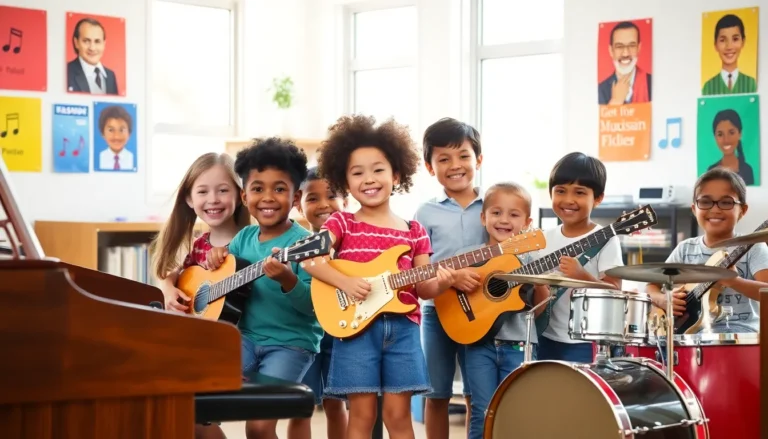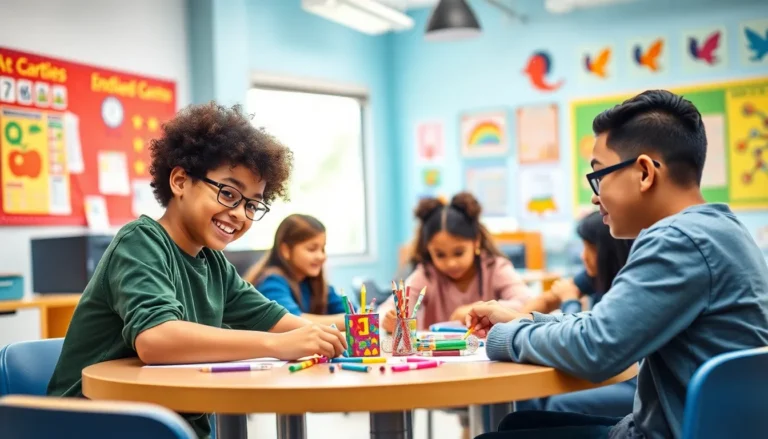In a world where knowledge is king and student debt reigns supreme, higher education is undergoing a transformation that even a chameleon would envy. From online learning to micro-credentials, today’s students are navigating a landscape that’s as dynamic as their TikTok feeds. It’s not just about hitting the books anymore; it’s about hitting the trends that can make or break a career.
Table of Contents
ToggleOverview of Higher Education Trends
The higher education landscape is shifting significantly, reflecting changes in societal needs and workforce demands. Many institutions emphasize online learning, allowing flexibility for students balancing work and study. Enrollments in online courses surged by 100% from 2019 to 2022, showcasing this trend’s popularity.
Micro-credentials are gaining traction, providing targeted skills for specific jobs. These short, focused programs cater to adult learners seeking to upskill quickly. Programs offering these credentials expanded by 30% in recent years, indicating their growing relevance.
Personalized learning experiences are becoming vital for student success. Adaptive learning technologies tailor educational content to individual needs, bolstering engagement and retention. Research shows personalized learning can improve students’ retention rates by up to 20%.
Furthermore, mental health support has emerged as a priority within higher education. Institutions are investing in counseling services and wellness programs to address student well-being. Around 75% of colleges reported increasing mental health services, responding to rising demand.
Globalization influences higher education, with many students choosing international study opportunities. Increasingly, campuses focus on diversity and inclusion initiatives, fostering a welcoming environment for all learners. As diverse perspectives enrich the educational experience, the demand for international programs grows.
Finally, tuition affordability remains a pressing concern for many students. Strategies such as tuition-free community college programs and increased financial aid aim to reduce student debt. In 2022, 45% of US students reported borrowing money for their education, highlighting the need for continued reform in financing higher education.
Technological Advancements

Technological advancements significantly shape higher education today. The integration of innovative tools enhances learning experiences.
Online Learning Platforms
Online learning platforms revolutionize access to education. Enrollments in these platforms surged by 100% from 2019 to 2022. Students appreciate the flexibility and self-paced nature of online courses, making it easier to balance work and studies. Institutions also embrace this trend, expanding their course offerings to meet student demand. Many universities utilize these platforms to offer valuable micro-credentials, which increased by 30% in recent years. This move caters to students seeking targeted skills for specific job markets.
Artificial Intelligence in Education
Artificial intelligence plays a crucial role in personalizing education. Adaptive technologies improve student retention rates by up to 20%. They analyze learning patterns and adapt materials accordingly, fostering engagement. AI-driven tools streamline administrative tasks, allowing educators to focus on student interactions. Institutions also leverage AI for better data-driven decision-making. Increased efficiency in processes supports students in achieving their academic goals, enhancing overall educational outcomes.
Changing Demographics
Shifting demographics significantly impact higher education enrollment and participation. The increasing diversity among students shapes classroom dynamics and educational experiences.
Increasing Diversity in Enrollment
Greater emphasis on diversity leads to varied backgrounds and perspectives within academic settings. Data shows that minority students constitute approximately 48% of total enrollments in US colleges as of 2022, reflecting a 15% increase from previous years. Programs that recruit underrepresented groups continue to expand, promoting inclusivity. Such initiatives enhance the richness of discussion and collaboration among students, fostering a more dynamic learning environment.
Age and Gender Trends
Age distribution among college students is evolving. Enrollment of adult learners aged 25 and older rose by 22% in the past three years, showcasing a commitment to lifelong learning. Gender trends are also notable, with women making up 59% of enrolled students in higher education institutions, a figure that has increased steadily. These shifts demand adaptive approaches to teaching and support services, addressing the diverse needs of a broad student population.
Student-Centric Approaches
Higher education increasingly emphasizes student-centric approaches, focusing on supporting overall student well-being and fostering individualized learning modes.
Mental Health and Wellness Initiatives
Mental health support leads higher education priorities. Approximately 75% of colleges enhanced counseling services recently due to rising demand. Colleges integrate wellness programs that include stress management workshops and peer support groups. Institutions understand that positive mental health significantly impacts academic performance and retention rates. Offering resources ensures students feel supported and valued, creating a healthier campus climate. Colleges also advocate for mental health awareness campaigns to destigmatize seeking help. These initiatives prioritize wellness, recognizing that student well-being directly correlates with success in academia.
Personalized Learning Experiences
Personalized learning experiences gain traction in modern education. Adaptive technologies enhance teaching methods, responding to individual learning styles and preferences. As a result, students experience improved engagement and retention rates, with increases of up to 20%. Colleges adopt platforms that allow for customized curricula tailored to specific academic goals. Enhanced feedback mechanisms ensure students receive timely guidance, adapting support as needed. Empowering learners to take control of their educational journeys fosters independence and motivation. Many institutions also offer flexible learning paths, reflecting diverse student needs and preferences. Prioritizing tailored educational experiences ensures that all students benefit from relevant and effective learning opportunities.
Globalization of Education
Globalization significantly shapes higher education today. Increased international student mobility reflects this trend, with students eager to pursue studies abroad. In 2022, approximately 5.3 million students studied outside their home countries, showcasing a 30% rise since 2015. Countries like the United States, the United Kingdom, and Australia remain popular destinations due to their renowned institutions and diverse cultures. Students often seek programs that offer global perspectives, enhancing their employability in a competitive workforce.
Collaborations and partnerships among institutions highlight the globalization of education. Universities now form alliances across borders, promoting joint programs, research initiatives, and student exchanges. Such collaborations enrich academic experiences while broadening networking opportunities for students. As a result, 55% of universities in the US established partnerships with foreign institutions by 2022. These strategic alliances help foster innovation and increase access to specialized resources, ultimately enhancing educational quality.
The trends in higher education are reshaping how students learn and prepare for the future. With a focus on flexibility and personalized experiences, institutions are responding to the demands of a diverse student body. The rise of online learning and micro-credentials reflects a shift towards skill-based education that aligns with today’s job market.
Mental health support and global opportunities are also critical components of this evolving landscape. As colleges continue to adapt to these trends, they foster environments that prioritize student well-being and success. Embracing these changes ensures that higher education remains relevant and accessible for all learners, paving the way for a more informed and skilled workforce.





